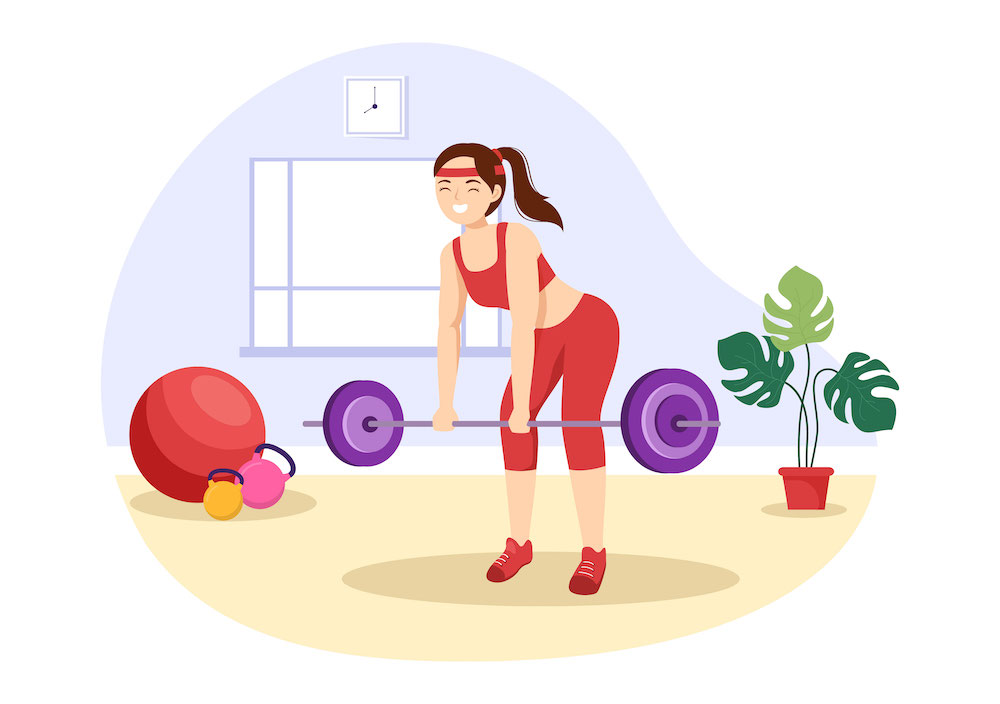The deadlift is a fundamental compound exercise that targets multiple muscle groups, making it a staple in any strength training routine. Contrary to popular belief, you don’t need a fully equipped gym to perform deadlifts; you can achieve impressive results right from the comfort of your own home. In this comprehensive guide, we’ll walk you through the proper form, equipment considerations, and safety precautions to help you master the art of the deadlift at home.

Why doing a deadlift?
Performing deadlifts offers a multitude of benefits that make it a cornerstone exercise in strength training and overall fitness. Here are some compelling reasons to include deadlifts in your workout routine:
- Full-body engagement: Deadlifts are a compound exercise, meaning they engage multiple muscle groups simultaneously. This includes your glutes, hamstrings, lower back, upper back, core, forearms, and grip muscles. This comprehensive engagement promotes balanced muscle development and functional strength.
- Strength gains: Deadlifts are known for their ability to build raw strength. The lifting motion involves lifting a heavy load from a dead stop, challenging your muscles to overcome resistance. This leads to increased muscle fibre recruitment and overall strength improvement.
- Posture and spinal health: Deadlifts encourage proper posture and spinal alignment. Engaging your core and maintaining a neutral spine throughout the lift can help alleviate back pain and improve your overall posture.
- Muscle hypertrophy: While deadlifts are renowned for strength gains, they also contribute to muscle growth. The compound nature of the exercise places significant stress on various muscle groups, stimulating hypertrophy (muscle growth) for a more sculpted physique.
- Metabolic boost: Deadlifts are demanding on your muscles and energy systems. Performing heavy compound movements like deadlifts can increase your metabolic rate, aiding in fat loss and weight management.
- Bone density: Weight-bearing exercises like deadlifts can help improve bone density, reducing the risk of osteoporosis and promoting overall bone health.
- Hormonal response: Deadlifts, especially when performed with heavy weights, trigger the release of growth hormone and testosterone. These hormones play a crucial role in muscle growth, repair, and overall well-being.
- Mental resilience: Conquering heavy deadlifts requires mental focus, discipline, and determination. Overcoming the challenge of lifting a heavy weight can boost your self-confidence and mental resilience.
Incorporating deadlifts into your fitness routine can yield a host of physical and mental benefits. However, it’s essential to learn and practice proper form to avoid injury. If you’re new to deadlifts, consider working with a fitness professional to ensure you’re performing the exercise correctly and safely.
This is how you do a deadlift
Step 1: Set up your home workout space:
Designate a clear area in your home where you can perform the deadlift safely. Ensure there’s enough space for you to stand with a barbell or weights, and that the floor is sturdy and flat to prevent any wobbling during the lift.
Step 2: Choose your equipment:
While traditional deadlifts are often performed with a barbell and weights, you can adapt this exercise to your home environment using alternative equipment such as dumbbells, kettlebells, or resistance bands. Opt for a weight that challenges you but allows you to maintain proper form throughout the movement.
Step 3: Perfect your form:
Proper form is crucial for maximizing results and minimizing the risk of injury. Follow these steps to ensure you’re performing a deadlift with correct form:
- Stand with your feet hip-width apart and the chosen equipment in front of you.
- Bend at your hips while keeping your back straight and chest up, lowering yourself to grip the equipment.
- Engage your core and glutes as you push through your heels, lifting the equipment off the ground.
- Keep the weight close to your body as you stand upright, maintaining a neutral spine.
- Reverse the movement by bending at your hips again and lowering the weight back to the ground.
Step 4: Breathing and core engagement:
Coordinate your breath with your movement. Inhale as you lower the weight and exhale as you lift. Focus on engaging your core muscles throughout the lift to provide stability to your spine.
Step 5: Start with light weights:
If you’re new to deadlifting, begin with light weights to familiarize yourself with the movement and ensure your form is spot on. Gradually increase the weight as you gain confidence and strength.
Step 6: Warm up and cool down:
Always warm up before diving into your deadlift routine. Incorporate dynamic stretches and light cardiovascular exercises to increase blood flow to your muscles. After your workout do a cooling down, engage in static stretching to aid in recovery and flexibility.
We love to make you move!
✓ Work out in front of your tv whenever you want
✓ 24/7 on-demand with more than 500 workouts
✓ For the whole family
Fit at Home is your NUMBER ONE fitness app. With our home workouts you don’t have to leave the house anymore to workout. Just turn on your TV and start your workout!

Dumbbell & Fit
With our Dumbbell & Fit workouts you will improve your strength. Besides training your arms you will train your whole body. The only thing you need is a set of dumbbells and your living room.